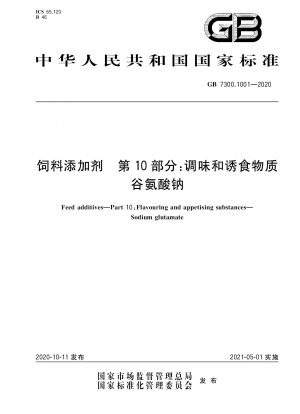GB 7300.1001-2020
Feed additive—Part 10:Flavouring and appetising substances—Sodium glutamate (English Version)
- Standard No.
- GB 7300.1001-2020
- Language
- Chinese, Available in English version
- Release Date
- 2020
- Published By
- 国家市场监督管理总局、中国国家标准化管理委员会
- Latest
- GB 7300.1001-2020
- Scope
- This part of GB7300 specifies the technical requirements, test methods, inspection rules, labeling, packaging, transportation and storage of the feed additive sodium glutamate. This part applies to the feed additive sodium glutamate made from starch, corn, molasses and other carbohydrates, which are fermented, extracted, neutralized, condensed, separated and dried by Corynebacterium glutamicum ia72ica72) and other microorganisms. (CCory7zeoacte7za772 SSLz-
GB 7300.1001-2020 Referenced Document
- GB 10648 Feed Label "No. 1 Amendment"*, 2020-12-24 Update
- GB 5009.43 National food safety standard Determination of sodium glutamate in monosodium glutamate*, 2023-09-06 Update
- GB/T 13079 Determination of total arsenic in feeds*, 2022-12-30 Update
- GB/T 13080 Determination of lead in feeds—Atomic absorption spectrometry
- GB/T 14699.1 Feeding stuffs--Sampling
- GB/T 602 Chemical reagent--Preparations of standard solutions for impurity
- GB/T 603 Preparation of preparations and products used in chemical reagent test methods*, 2023-08-06 Update
- GB/T 6435 Determination of moisture in feedstuffs
- GB/T 6682 Water for analytical laboratory use.Specification and test methods
- GB/T 8170 Rules of rounding off for numerical values & expression and judgement of limiting values
GB 7300.1001-2020 history
- 2020 GB 7300.1001-2020 Feed additive—Part 10:Flavouring and appetising substances—Sodium glutamate

GB 7300.1001-2020 -All Parts
GB 7300.1001-2020 Feed additive—Part 10:Flavouring and appetising substances—Sodium glutamate
GB 7300.1002-2022 Feed additives—Part 10: Flavouring and appetising substances—Allicin
GB 7300.101-2019 Feed additives—Part 1:Amino acids, their salts and analogues—L-Threonine
GB 7300.102-2019 Feed additives—Part 1:Animo acids,their salts and analogues—Glycine
GB 7300.103-2020 Feed additives—Part 1:Amino acids, their salts and analogues—Methionine hydroxy analogue
GB 7300.104-2022 Feed additives—Part 1:Amino acids,their salts and analogues—L-Valine
GB 7300.201-2019 Feed additives—Part 2:Vitamins,provitamins and chemically well-defined substances having similar effect—L-Ascorbyl-2-phosphate
GB 7300.202-2019 Feed additives-Part 2:Vitamins, provitamins and chemically well-defined substances having similar effect-Vitamin D3 oily form
GB 7300.203-2020 Feed additive—Part 2:Vitamins, provitamins and chemically well-defined substances having similar effect—Betaine
GB 7300.204-2019 Feed additives—Part 2:Vitamins,provitamins and chemically well-defined substances having similar effect—Betaine hydrochloride
GB 7300.301-2019 Feed additives—Part 3:Minerals and their complexes (or chelates)—Potassium iodide
GB 7300.302-2019 Feed additives—Part 3:Minerals and their complexes (or chelates)—Sodium selenite
GB 7300.303-2022 Feed additives—Part 3: Minerals and their complexes (or chelates)—Potassium iodate
GB 7300.401-2019 Feed additives—Part 4:Enzymes—Xylanase
GB 7300.402-2020 Feed additives—Part 4:Enzymes—Phytase
GB 7300.403-2022 Feed additives—Part 4:Enzymes—Cellulase
GB 7300.501-2021 Feed additives —Part 5:Live microorganisms—Saccharomyces cerevisiae
GB 7300.502-2023 Feed additives —Part 5:Live microorganisms —Lactobacillus plantarum
GB 7300.503-2023 Feed Additives Part 5: Microorganisms Enterococcus faecium
GB 7300.504-2023 Feed additives-Part 5: Microorganism Lactobacillus acidophilus
GB 7300.601-2020 Feed additives-Part 6:Non-protein Nitrogen-Urea
GB 7300.801-2019 Feed additives—Part 8:Preservatives and acidity regulators—Sodium bicarbonate
GB 7300.802-2023 Feed Additives Part 8: Preservatives, Antifungals and Acidity Regulators Propionic Acid
GB 7300.901-2019 Feed additives—Part 9:Coloring agents—β-Carotene powder
GB 7300.902-2022 Feed additives—Part 9: Coloring agents—beta,beta-carotene-4,4-diketone(Canthaxanthin)